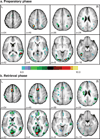Left posterior parietal cortex participates in both task preparation and episodic retrieval
- PMID: 19285142
- PMCID: PMC3339571
- DOI: 10.1016/j.neuroimage.2009.02.044
Left posterior parietal cortex participates in both task preparation and episodic retrieval
Abstract
Optimal memory retrieval depends not only on the fidelity of stored information, but also on the attentional state of the subject. Factors such as mental preparedness to engage in stimulus processing can facilitate or hinder memory retrieval. The current study used functional magnetic resonance imaging (fMRI) to distinguish preparatory brain activity before episodic and semantic retrieval tasks from activity associated with retrieval itself. A catch-trial imaging paradigm permitted separation of neural responses to preparatory task cues and memory probes. Episodic and semantic task preparation engaged a common set of brain regions, including the bilateral intraparietal sulcus (IPS), left fusiform gyrus (FG), and the pre-supplementary motor area (pre-SMA). In the subsequent retrieval phase, the left IPS was among a set of frontoparietal regions that responded differently to old and new stimuli. In contrast, the right IPS responded to preparatory cues with little modulation during memory retrieval. The findings support a strong left-lateralization of retrieval success effects in left parietal cortex, and further indicate that left IPS performs operations that are common to both task preparation and memory retrieval. Such operations may be related to attentional control, monitoring of stimulus relevance, or retrieval.
Figures





References
-
- Buckner RL, Goodman J, Burock M, Rotte M, Koutstaal M, Schacter DL, Rosen B, Dale AM. Functional-anatomic correlates of object priming in humans revealed by rapid presentation event-related fMRI. Neuron. 1998a;20:285–296. - PubMed
-
- Buckner RL, Koutstaal W, Schacter DL, Wagner AD, Rosen BR. Functional-anatomic study of episodic retrieval using fMRI: I Retrieval effort versus retrieval success. Neuroimage. 1998b;7:151–162. - PubMed
Publication types
MeSH terms
Grants and funding
LinkOut - more resources
Full Text Sources
Medical

